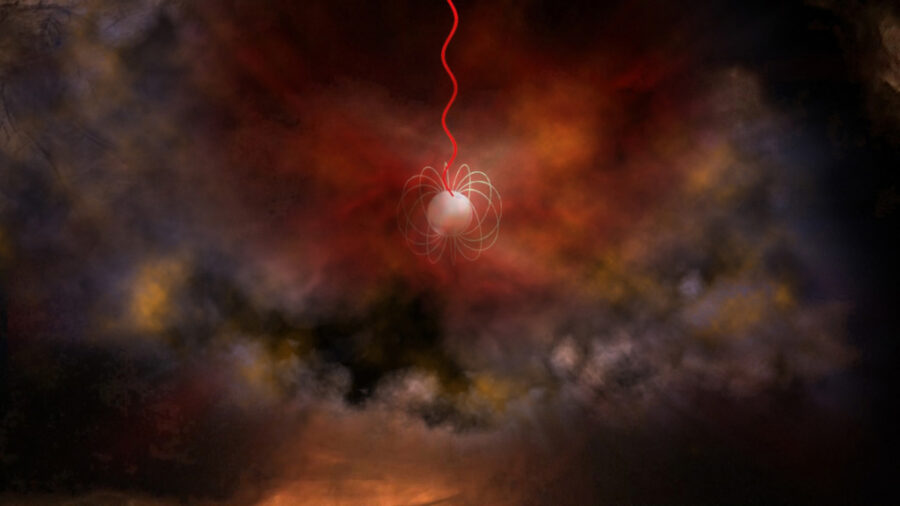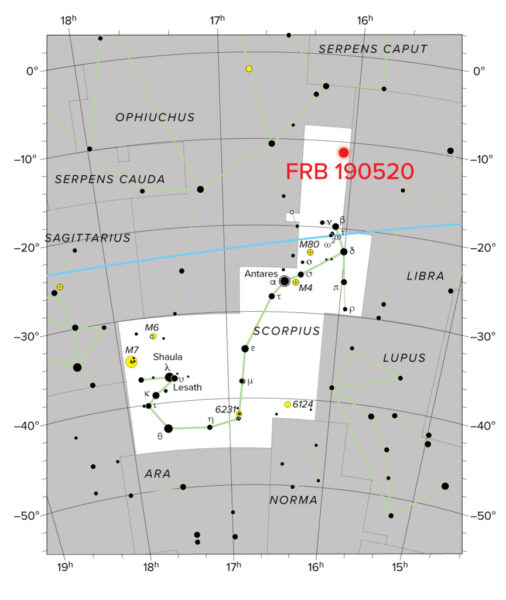A new source of fast radio bursts raises questions about how much we really know about these mysterious flares.

Bill Saxton, NRAO / AUI / NSF
Just when we were beginning to think we understand the mysterious radio flashes known as fast radio bursts (FRBs), new observations have come to light that make clear how much we still have to learn.
The milliseconds-long bursts of radio waves mostly originate in sources far outside our own galaxy. But in 2020, a magnetar in the Milky Way emitted something very like a fast radio burst, only much fainter. Though questions remained about just how a magnetar could unleash such powerful flares, the mystery seemed to have a zeroth-order solution.
Now, the detection of a new FRB has thrown things out of whack. Announcing the discovery of FRB 20190520B in Nature, Di Li (Chinese Academy of Sciences) and colleagues emphasize that this FRB is one of a kind. Not only could it complicate our understanding of FRBs in general, it may even throw off studies seeking to use these sources as cosmological probes.

Niu et al. / Nature 2022; Bill Saxton, NRAO / AUI / NSF; CFHT
An Exceptional Fast Radio Burst
The FRB was an exception from the beginning as it flared again and again in observations recorded by the Five-hundred-meter Aperture Spherical radio Telescope (FAST), which nestles among the hills of China’s Guizhou province. The multiple flares put the source among the few percent of FRBs that repeat. But unlike most repeaters, this one doesn’t have any apparent cycle of bursting and quiescence.
“FRB 20190520B is the only persistently repeating fast radio burst known so far, meaning that it has not been seen to turn off,” Li says.
In addition, whatever made the FRB is also emitting a constant buzz of radio waves. Astronomers have found an association with a persistent radio source in only two other FRBs, and for one of these the low-level radio waves seem to come from ongoing star formation in the host galaxy. For FRB 20190520B, though, the radio source is far more compact, and Li’s team thinks the radio waves probably come from the FRB source itself.
The Plot Thickens
Perhaps most importantly to researchers, the FRB seems to reside in an extreme environment of strong magnetic fields and an abundance of ionized gas. Li and colleagues figured this out by looking at the FRB’s smear across frequency, known as its dispersion measure.
This smearing effect occurs when radio waves pass through plasma, and FRBs have a lot of it. Astronomers think the high dispersion measures come from the sparse gas the radio waves encounter in their long travels through intergalactic space. As such, astronomers could utilize FRB signals to investigate the density and distribution of intergalactic gas.
But Li’s team used the Karl G. Jansky Very Large Array in New Mexico and the Canada-France-Hawaii Telescope on Mauna Kea to pinpoint the location of FRB 20190520B to a dwarf galaxy 2.9 billion light-years away, with only 0.8% probability that the two align by chance. But if all of the FRB’s frequency smear had come from intergalactic passage, the radio waves would have had to travel for more than 7 billion years. The researchers realized that the large amount of smearing in the signal had to come not from sparse intergalactic gas but from much denser plasma around the FRB itself.
“I agree with the paper's suggestion that the high dispersion measure is probably due to the immediate environment of the FRB source, rather than the whole host galaxy,” says Adam Lanman (McGill University, Canada), an FRB researcher who wasn’t involved in the study.
“So far, this one appears to be an outlier,” he adds. “But if more sources like it are found, then the usefulness of FRBs as cosmological probes will be more limited.”

Bill Saxton, NRAO / AUI / NSF
The discovery also throws into question whether magnetars are behind all FRBs, an idea that many already doubt. Different types of FRBs abound, and the unique properties of this one only complicates categorization.
“I would say that this discovery favors an explosive event, such as an extremely bright supernova that would also explain the persistent radio source,” Li contends. “But I cannot say that it rules out a magnetar.”
Expect to hear more about this FRB: Li says that follow-up observations have already resulted in multiple additional studies that are being prepared and published.
 2
2









Comments
RC Silk
June 11, 2022 at 11:12 am
A repeating FRB indicates one of two conditions:
A) the FRB source is in motion, either rotating or revolving in some manner as to periodically be visible / not visible, or
B) the FRB is "eating" much like in the manner of a black hole.
Sure, go ahead, claim otherwise if you like, after all, every idea has an equal yet opposite counter-idea.
(No, it *doesn't!*)
You must be logged in to post a comment.
Martian-Bachelor
June 26, 2022 at 2:57 pm
> the large amount of smearing in the signal had to come not from sparse
> intergalactic gas but from much denser plasma around the FRB itself.
This was pretty obvious awhile ago. The assumption that the DM's were due to ionized material not associated with the FRB(s) was always just that, an assumption. It always made more sense (to me at least) that the same energy source creating the radio waves was ionizing nearby gas, so that the dispersion was local.
But then I don't think FRBs are at the great distances seemingly assumed by everyone, since no one knows how to measure the distance to one. The large distances assumed are based on their isotropic distribution on the sky, and the fact that the extragalactic radio sources catalogued decades ago are typically out at a billion parsecs (give or take), but because the Milky Way is several hundred parsecs thick they could be at distances of only tens or dozens of parsecs and also show an isotropic distribution. The only fly in this ointment is the one apparently in a globular cluster in M81, though it's difficult to account for any FRB being in such a place.
You must be logged in to post a comment.
You must be logged in to post a comment.